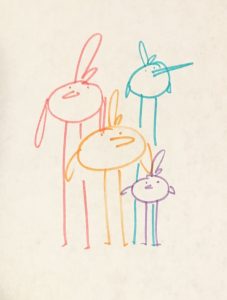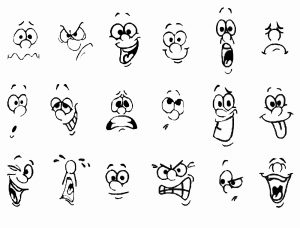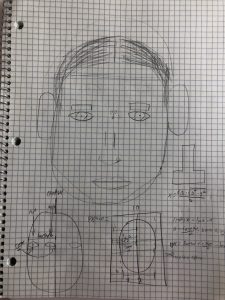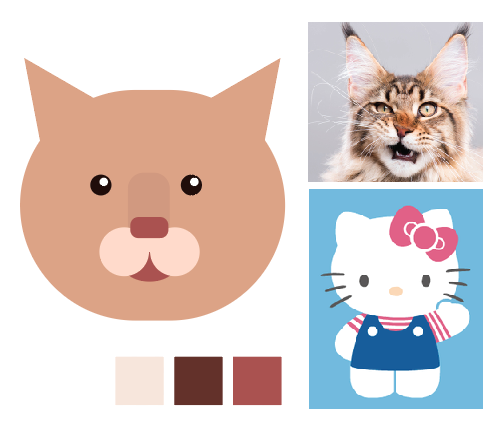var eyeSize = 20;
var faceWidth = 100;
var faceHeight = 150;
var earSize = 15;
var headphoneSize = 6;
var colorPicker = 1;
var faceColor = 2;
var mouthWidth = 3;
var mouthHeight = 4;
var eyebrowWidth = 5;
var eyebrowHeight = 6;
function setup() {
createCanvas(300, 300);
}
function draw() {
//background
switch(colorPicker) {
case 1:
background(252, 156, 231);
break;
case 2:
background(230, 156, 252);
break;
case 3:
background(156, 193, 252);
break;
case 4:
background(252, 249, 156);
break;
default:
background (161, 252, 156);
}
//headphones
noFill();
stroke('black');
strokeWeight(4);
curve(width / 2 - faceWidth * 1, height * 3.5, width / 2 - faceWidth / 1.75, height / 2, width / 2 + faceWidth / 1.75, height / 2, width / 2 + faceWidth * 1, height * 3.5);
//ears
fill('black');
noStroke();
ellipse(width / 2 - faceWidth / 2, height / 2, earSize, earSize*1.5);
ellipse(width / 2 + faceWidth / 2, height / 2, earSize, earSize*1.5);
//face
switch(faceColor) {
case 1:
fill(252, 156, 176);
break;
case 2:
fill(204, 139, 224);
break;
case 3:
fill(139, 171, 224);
break;
case 4:
fill(242, 239, 145);
break;
default:
fill(143, 224, 139);
}
noStroke();
ellipse(width / 2, height / 2, faceWidth, faceHeight);
//hearteyes
fill('pink');
stroke('black');
strokeWeight(1);
var eyeLX = width / 2 - faceWidth * 0.25;
var eyeRX = width / 2 + faceWidth * 0.25;
//lefteye
curve(width / 2 + width * .75, height / .75, eyeLX, height / 2.0, eyeLX, height / 1.8, width / 2, height / 1.5);
curve(width / 2 - width * .75, height / .75, eyeLX, height / 2.0, eyeLX, height / 1.8, width / 2, height / 1.5);
//righteye
curve(width / 2 + width * .75, height / .75, eyeRX, height / 2.0, eyeRX, height / 1.8, width / 2, height / 1.5);
curve(width / 2 - width * .75, height / .75, eyeRX, height / 2.0, eyeRX, height / 1.8, width / 2, height / 1.5);
//nose
noFill();
curve(width / 2 + faceWidth / 2, height / 2 + faceHeight / 2, width / 2 - faceWidth / 16, height / 2 + faceHeight / 6, width / 2 + faceWidth / 16, height / 2 + faceHeight / 6, width / 2 - faceWidth / 2, height / 2 + faceHeight / 2);
//mouth
arc(width / 2, height / 1.6, mouthWidth, mouthHeight, TWO_PI, PI, OPEN);
//eyebrows
arc(width / 2 - faceWidth / 3.5, height / 2.5 + faceHeight / 12, eyebrowWidth, eyebrowHeight, PI, TWO_PI, OPEN);
arc(width / 2 + faceWidth / 3.5, height / 2.5 + faceHeight / 12, eyebrowWidth, eyebrowHeight, PI, TWO_PI, OPEN);
}
function mousePressed() {
faceWidth = random(80, 100);
faceHeight = random(140, 165);
eyeSize = random(10, 30);
earSize = random(25, 40);
headphoneSize = random(3, 8);
colorPicker = int(random(1, 6));
faceColor = int(random(1, 6));
mouthWidth = faceWidth / random(2, 4);
mouthHeight = faceHeight / random(2.5, 4.5);
eyebrowWidth = faceWidth / random(3.5, 4);
eyebrowHeight = faceHeight / random(8, 10);
}i really enjoyed this project because i enjoyed designing throughout the code and trying new things as i went along instead of looking for one specific solution which i may have been trying too hard to do last week.
![[OLD FALL 2018] 15-104 • Introduction to Computing for Creative Practice](https://courses.ideate.cmu.edu/15-104/f2018/wp-content/uploads/2020/08/stop-banner.png)



